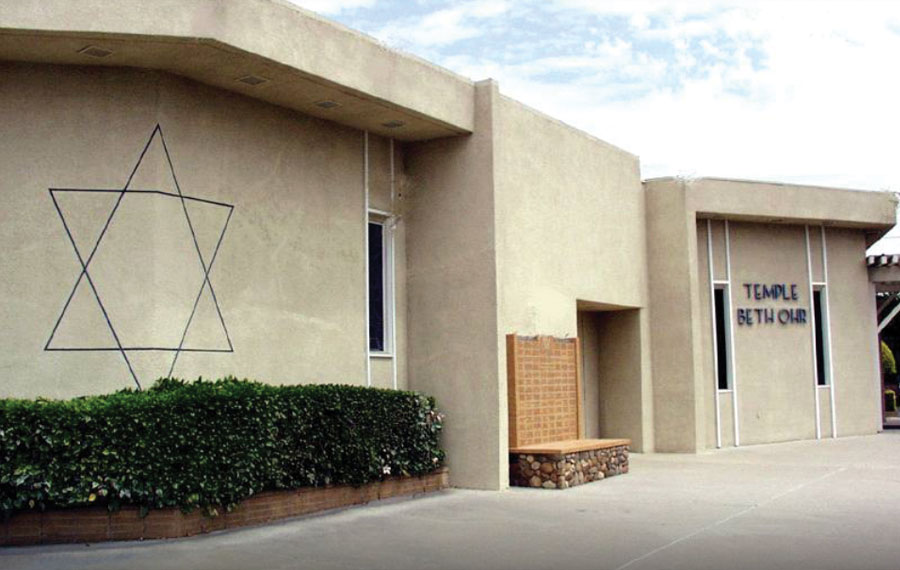 Temple Beth; Ohr Photo courtesy of Temple Beth Ohr
Temple Beth; Ohr Photo courtesy of Temple Beth Ohr As the Los Angeles Jewish community prepares to celebrate its first High Holy Days since the deadly shootings at Pittsburgh’s Tree of Life synagogue and Chabad of Poway, synagogues are working to ensure the safety of their congregants.
Deterrence plays a major part in the effort, Doug Kotkin, chair of the security and safety committee at Temple Beth Ohr in La Mirada, told the Journal.
The synagogue is expecting approximately 200 people for the High Holy Days, and Kotkin said the entrance to the shul would now have ID scanners.
“In the past, if you didn’t have a ticket you went on through,” Kotkin said. “Now everything is done outside. Those without tickets will be ID scanned.”
The synagogue is located in an area that doesn’t have active hate groups, Kotkin said, but it nonetheless has hired two retired police officers for High Holy Days services. And although they won’t be patting down people or checking purses, the officers will “be keeping an eye out for anything suspicious,” Kotkin said.
Additionally, the synagogue had a Sheriff’s Department official do a walk-through of the site and went through safety procedures with Temple Beth Ohr staff.
“Our primary objective is to make sure people feel safe and are safe. One of those challenges is balancing being welcoming with being secure.” — Melissa Balaban, IKAR
At IKAR, which holds services at Shalhevet High School and draws up to 4,000 people during the High Holy Days, Executive Director Melissa Balaban said in addition to security staff, congregants play an invaluable role in creating a safe synagogue environment.
“I think it’s a mistake for folks to think security is being taken care of for them,” she said. “No amount of security can take the place of people taking care of one another and being on alert for things that might be problematic.”
The key, Balaban added, is balance. “Our primary objective is to make sure people feel safe and are safe. One of those challenges is balancing being welcoming with being secure.”
And security is definitely the watchword, particularly when the Anti-Defamation League’s (ADL) audit of anti-Semitic incidents in 2018 revealed California as the state with the highest number of anti-Semitic incidents.
During a recent pre-High Holy Days security briefing, ADL Regional Director Ariella Lowenstein said security isn’t just for synagogues with large budgets. There are also low-cost, practical ways to create more secure environments. Some of those, she said, include liaising with local law enforcement so that in the event of an incident, the synagogue knows who to contact; establishing procedures for controlling access to facilities; and designating a member of staff to serve as a security manager.
At Temple Beth Ohr, Kotkin said it isn’t possible to have multiple checkpoints before people enter the synagogue because there are no gates outside the shul and the parking lot isn’t secure. However, he said they do employ other methods including assigning different members of the security team to focus on different elements of security.
At IKAR, the safety team includes lay leaders and staff who have worked with security consultants on figuring out “pieces we need to put in place,” Balaban said, adding that IKAR is committed to “making sure we are available and open to people who are unaffiliated and may not have planned three months in advance for High Holy Days and have a safe place to sit.”
And like Kotkin, Balaban said IKAR is in close touch with law enforcement.
“It’s such a changing landscape. What security looked like at IKAR 15 years ago is drastically different from what it looks like in this day and age,” she said. “With the relatively frequent public shootings in places of worship, we need to be aware of that and plan accordingly.”
For additional tips on synagogue security, visit the ADL website.























 More news and opinions than at a Shabbat dinner, right in your inbox.
More news and opinions than at a Shabbat dinner, right in your inbox.